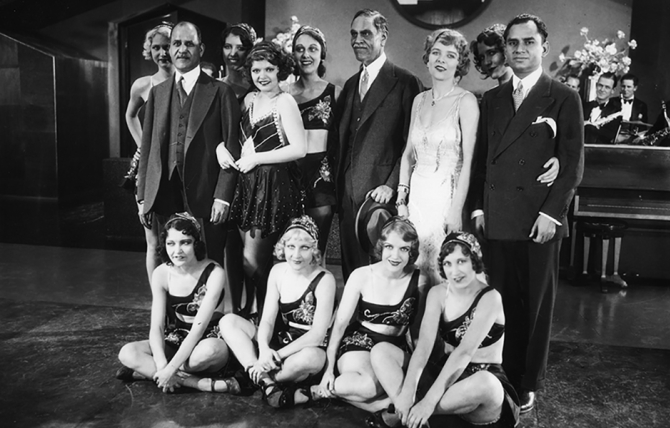On the set of "The Woman Racket" at Metro-Goldwyn-Mayer Studios, Sir Jagjit Singh of India (in the center with moustache) is surrounded by a group of young starlets and chorus girls. 1930 – Eyre Powell Chamber of Commerce Collection
Metro-Goldwyn-Mayer (MGM) was the movie studio known for “More stars than there are in heaven.” During its heyday in the 1930s and ‘40s, MGM's roster of luminaries included Clark Gable, Judy Garland, Greta Garbo, Joan Crawford, Norma Shearer, Jean Harlow, Elizabeth Taylor, and countless others. Their mascot “Leo the Lion” conjured up images of Hollywood’s best musicals, dramas, comedies, and epic films.
Formed in 1924, Louis B. Mayer was given the role of studio chief and 24-year-old "boy wonder" Irving Thalberg became the head of production. Quickly producing a string of silent-era hit pictures such as He Who Gets Slapped and The Big Parade, MGM became the most profitable film company in Hollywood. This success continued into the era of “talking pictures.”
As the country spiraled into economic depression, Metro-Goldwyn-Mayer was the only studio to post a profit in the early 1930’s. Films like Grand Hotel and Red Dust helped to maintain its top position. This sustained success was due in large part to Thalberg who brought a level of unmatched sophistication and polish to the MGM productions he oversaw. His marriage to one of the studio’s most popular leading ladies, Norma Shearer further enhanced his reputation, and together they were viewed as the ideal Hollywood couple. Sadly, Thalberg’s life-long frail health resulted in his untimely death at the age of 37 in 1936. The producer had spent years cultivating a roster of behind-the-scenes craftspeople whose talent and expertise helped maintain Thalberg’s vision of excellence long after his demise.
Upon fully taking the helm, Louis B. Mayer determined that all Metro-Goldwyn-Mayer films would be produced with a stamp of moral excellence. Wholesome musicals and family series such as Andy Hardy and The Thin Man were mainstays of the studio releases. Under Mayer’s watch, 1939 proved to be the golden year for MGM. In addition to producing The Wizard of Oz and Goodbye Mr. Chips, among many other titles, MGM distributed Gone with the Wind for Selznick International.
Metro-Goldwyn-Mayer continued to thrive in the 1940s, but by the early 1950s Louis B. Mayer was gone and the studio started on a steep decline for a variety of reasons. Many of the studio's biggest stars were gone, the dominance of the studio system was diminishing, and the approach of television saw movie theater attendance fall to an all-time low.
MGM was in chaos through the 1960’s despite occasional hit feature such as Doctor Zhivago, and 2001: A Space Odyssey. In 1969 businessman Kirk Kerkorian purchased a large chuck of Metro-Goldwyn-Mayer and began a slow dismantling of its assets, selling the backlot as well as the contents of the studio in a multi-day auction. That’s Entertainment, a retrospective of the studio’s fifty-year history was released in 1974. The film celebrated the achievements of Metro-Goldwyn-Mayer, but also served as a sad reminder of how far this once mighty studio had fallen since the Golden Age of Hollywood.
Throughout the history of MGM, the photographer’s lens captured the history of the studio, documenting productions, premieres, and of course more stars than there are in heaven. The Los Angeles Public Library’s photo collection contains countless images of the fabled studio, from its earliest days in 1924, up to 1970 auction where so much of MGM’s history walked away with the highest bidder. The physical studio and the name Metro-Goldwyn-Mayer are now only a shadow of a once towering figure, but these photos are a document to just how large MGM loomed.
- Darin Barnes, Curator
